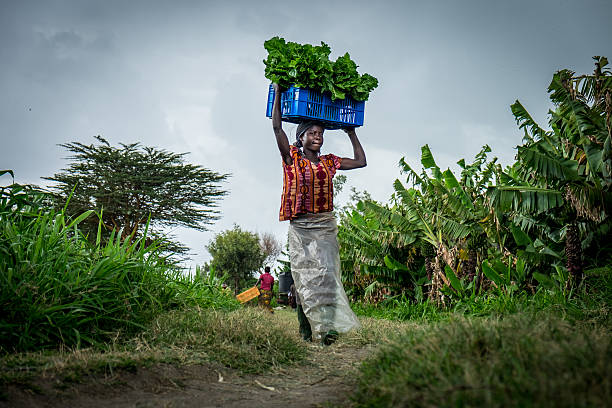

In a world of increasing wealth and technological advances, the issues of food security and nutrition remain central to the well-being of humanity. While some regions enjoy a surplus of food, others continue to grapple with hunger, malnutrition, and food insecurity. Addressing these challenges is critical, not only for alleviating hunger but for promoting long-term sustainable development across the globe.
What is Food Security?
Food security, as defined by the United Nations, exists when all people, at all times, have physical, social, and economic access to sufficient, safe, and nutritious food that meets their dietary needs and food preferences for an active and healthy life. This definition emphasizes four key dimensions:
- Availability: The sufficient production and supply of food at local, national, and global levels.
- Access: The ability of individuals to obtain food, either through purchase, farming, or support systems.
- Utilization: Ensuring that the food consumed is nutritious and meets dietary needs, which includes factors like food preparation, diversity of diets, and health conditions that affect nutrient absorption.
- Stability: A continuous and predictable supply and access to food over time, even during crises or shocks such as natural disasters, economic downturns, or conflict.
Achieving food security involves more than just providing enough calories. It also requires ensuring that food is nutritious and culturally appropriate, recognizing that malnutrition can manifest both as hunger and as obesity or undernutrition due to poor-quality diets.
The Global State of Food Security
According to the Food and Agriculture Organization (FAO), the number of people facing hunger globally has been steadily rising, particularly due to the combined impacts of climate change, conflict, and economic instability. As of recent reports, nearly 768 million people suffer from chronic hunger, while over 2 billion face moderate or severe food insecurity.
Sub-Saharan Africa, parts of Asia, and Latin America continue to experience the highest levels of food insecurity, driven by a combination of factors including inadequate infrastructure, political instability, and the adverse effects of climate change on agriculture. Despite progress in some regions, millions of families still struggle to access food, while others lack the resources needed to cultivate their own food supply.
The Link Between Food Security and Nutrition
Nutrition is closely linked to food security, as access to food alone is insufficient to ensure health and well-being. Malnutrition occurs when diets do not provide the right balance of nutrients, leading to a range of health problems. This can occur due to both undernutrition (lack of essential nutrients) and overnutrition (excess intake of unhealthy foods), which contributes to diseases such as diabetes, heart disease, and obesity.
For vulnerable populations, including children, pregnant women, and the elderly, proper nutrition is even more critical. Inadequate nutrition during pregnancy, infancy, and childhood can result in stunted growth, impaired cognitive development, and lifelong health issues.
The double burden of malnutrition—a situation where undernutrition and obesity exist side by side—is becoming increasingly prevalent, especially in developing countries. Urbanization and changing food environments have led to the growing availability of cheap, calorie-dense, and nutrient-poor processed foods, contributing to rising obesity rates even in regions with high levels of undernutrition.
Barriers to Achieving Food Security and Nutrition
Several complex factors contribute to food insecurity and poor nutrition:
- Climate Change: Rising temperatures, shifting rainfall patterns, and extreme weather events are disrupting agricultural systems. Crops fail, livestock die, and fisheries are affected, reducing food availability and driving up prices.
- Conflict and Political Instability: War and violence displace millions of people, disrupt supply chains, and destroy farmlands and infrastructure. Refugees and internally displaced persons often face severe food shortages, relying on international aid for survival.
- Poverty: Economic hardship is one of the biggest barriers to food security. Even in regions where food is available, many families cannot afford to buy enough nutritious food. Income inequality exacerbates this, leaving the poorest populations more vulnerable to hunger and malnutrition.
- Agricultural Challenges: Many smallholder farmers face difficulties accessing modern technology, quality seeds, and fertilizers. Lack of investment in agricultural infrastructure, such as irrigation and storage facilities, also hampers productivity.
- Gender Inequality: Women, especially in rural areas, are often responsible for food production and preparation. However, they face significant barriers to accessing land, credit, and education. Empowering women with the resources and knowledge they need can have a profound impact on food security and nutrition outcomes.
Strategies for Enhancing Food Security and Nutrition
Addressing food security and nutrition requires a multi-faceted approach that tackles the root causes of hunger and malnutrition while promoting sustainable food systems. Key strategies include:
- Promoting Sustainable Agriculture: Supporting smallholder farmers, particularly women, to adopt sustainable agricultural practices can boost productivity while preserving the environment. Encouraging the use of climate-resilient crops and agroecological farming methods can help build resilience against climate change.
- Improving Food Systems: Strengthening supply chains, investing in food storage, and reducing post-harvest losses can improve food availability and reduce waste. Ensuring that nutritious foods, such as fruits, vegetables, and legumes, are affordable and accessible is vital.
- Education and Awareness: Raising awareness about healthy diets and proper nutrition, particularly among children and expectant mothers, can improve nutrition outcomes. Education campaigns that promote local, nutrient-rich foods can also help combat malnutrition.
- Social Safety Nets: Implementing social protection programs, such as food assistance, cash transfers, and school meal programs, can provide a safety net for vulnerable populations, ensuring they have access to food even during times of crisis.
- Global Cooperation: International organizations, governments, and NGOs must work together to tackle food insecurity and malnutrition. This includes improving aid programs, sharing agricultural innovations, and supporting countries in crisis with emergency food supplies.
Conclusion
Food security and nutrition are essential for the well-being of individuals and the sustainable development of societies. Ensuring that everyone has access to safe, nutritious, and sufficient food must remain a global priority. By addressing the underlying causes of food insecurity, promoting sustainable agricultural practices, and ensuring equitable access to resources, the world can make significant strides in eradicating hunger and malnutrition for future generations.
